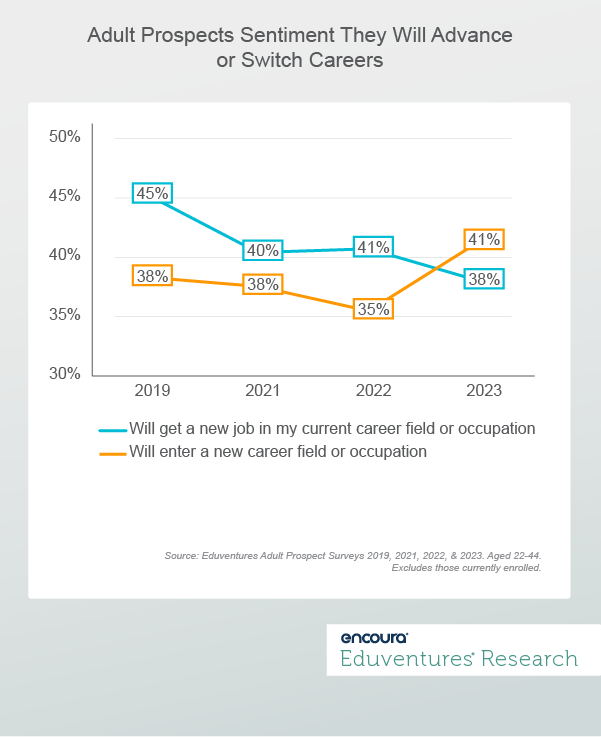The labor market landscape provides the backdrop for nearly all prospective student enrollment decisions, especially among adult learners who are typically already in the workforce. But the economy is continuing to send mixed signals—including a tight labor market and worker shortages, coupled with more job cuts in 2023 than any year since the Great Recession.
Within this context, is the labor market inhibiting prospective students from pursuing education, or priming them? To better read the tea leaves, Eduventures’ Adult Prospect Research™ has important insights into how adult prospects feel about their current careers, which is also a vital factor in their enrollment decisions.
Labor Market Rebalancing
Over the four years since the onset of the COVID-19 pandemic, the labor market is still settling. Higher education keeps a close eye on signs of recession—a challenging labor market (less hiring, especially) spurs more people to pursue education, particularly graduate and adult undergraduate students. And the market continues to send mixed signals.
While the unemployment rate has reverted to historically low pre-pandemic levels (between 3.7%-3.9%), the employment-to-population ratio has also remained low due to an increase in retirees and fewer people in the workforce. Inflation and consumer spending remain stubbornly high despite interest rate hikes.
Job cuts hover around 30-40% above the 2018 baseline, shown in Figure 1 below, following a huge pandemic spike in 2020. Meanwhile, total unique job postings grew steadily throughout the pandemic and in subsequent years, as if employers were unbothered by closures and other challenges. In fact, in 2021 and 2022, there was substantial growth in unique job postings (+31% in 2021 and +46% in 2022).
Figure 1.
In 2023, job cuts accelerated, up 34% compared to 2018 and doubling from 2022. Unique job postings, which had been growing steadily year-over-year, showed signs of slowing in 2023 (+17% compared to 2018 but down from 2022). The financial and technology industries, where higher levels of education are more common, were most likely to cut jobs, often citing “market/economic conditions.”
While unemployment is low and recent jobs reports have beaten expectations, April’s jobs report added the fewest jobs in six months, signaling potential economic challenges. The Wall Street Journal reports that while economic indicators are broadly positive, the average American remains pessimistic about the actual economy.
Given these mixed messages, how do adult prospects feel about their careers?
How Adult Prospects Think About Their Careers
In 2019, 45% of adult prospects aged 22 to 44 indicated they would “definitely” or “probably” seek a new job in their current career field or occupation. We see this as a proxy for career advancement.
In 2023, however, just 38% of these prospects indicated they would seek a new job in their current career field or occupation (with a corresponding increase of adults who will NOT seek a new job in their current career field or occupation). This could be a product of labor market tightness—a realization that jobs are not as plentiful as in prior years. These findings are shown in Figure 2.
Figure 2.
Figure 2 also shows that, at the same time, 41% of adult prospects indicated they would “definitely” or “probably” enter a new career field or occupation in 2023, up from 35% in 2022 and 38% in 2019. We see this as a proxy for job satisfaction. This finding ultimately indicates a decrease in job satisfaction.
The Eduventures Adult Prospect Research also shows an increase in the number of “committed” adult prospects aged 22 to 44 in our sample: those who indicate the greatest likelihood of enrolling in a college or university. Notably, 33% of adult prospects in 2023 were "committed", slightly higher than even the pre-pandemic 2019 sample of 31%.
Combined, this data paints a picture that adult prospects (aged 22-44) are showing decreased job satisfaction, decreased interest in career advancement, but increased interest in enrolling in a college or university in the future.
These signs, while still early in 2024, may signal a potential boon for adult prospects in coming years as long-term job dissatisfaction and a more challenging labor market could lead these prospects to furthering their educations to change their career trajectories.
The Bottom Line
Career growth and earning potential have always been key drivers of adult prospect enrollment. But the labor market seems to have fundamentally shifted away from common patterns in recent years (i.e., high interest rates hardly cool inflation, while unemployment remains low).
Now businesses are looking at artificial intelligence (AI) as a way to combat labor market shortages, especially in the finance and technology sectors. Human-intensive occupations, like manufacturing, hospitality, and healthcare may be less immune to technology replacement, at least in the short term.
Given emerging indicators of labor market and career unsteadiness, signs point to more adult prospect interest in higher education in the near future. Right now, institutions can capitalize on short-term education needs of dissatisfied workers in the form of skills-focused, non-degree programming. At the same time, institutions need to proactively evaluate their program portfolios and better position them long-term.



